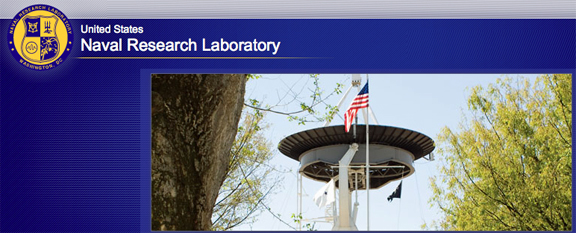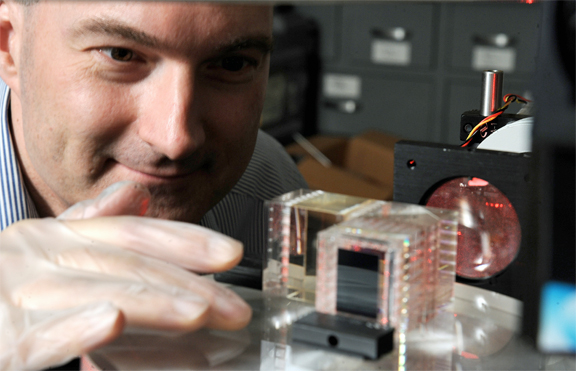
[SatNews] A U.S. Naval Research Laboratory (NRL) instrument designed to study the Earth's thermosphere is part of a satellite mission that NASA has officially confirmed, with launch expected in 2017.

NRL's Dr. Christoph Englert examines the prototype Michelson interferometer (MIGHTI) being developed at NRL for flight on NASA's ICON mission.
Photo is courtesy of U.S. Naval Research Laboratory/Jamie Hartman.
The NRL Space Science Division (SSD) developed Michelson Interferometer for Global High-resolution Thermospheric Imaging (MIGHTI) satellite instrument is part of NASA's Ionospheric Connection Explorer (ICON) mission. This mission, led by Dr. Thomas Immel at the University of California, Berkeley, will fly a suite of instruments designed to explore the mechanisms controlling the environmental conditions in space and how they are modified by weather on the planet. In studying this region where Earth's weather and space weather meet, researchers hope to find answers to their questions about how Earth's upper atmosphere behaves, since this part of the atmosphere is essential for the performance of many systems that use long-distance radio wave propagation.
Ionospheres act as a boundary between planetary atmospheres and space, containing weakly ionized plasmas that are strongly coupled to their neutral atmospheres, but also influenced by the conditions in the space environment. They are mainly influenced by the influx of solar energy and particles but also by dynamical forcing from the planetary atmosphere below, resulting in a remarkable set of non-linear behaviors, explains NRL's Dr. Christoph Englert. The unpredictable variability of the Earth's ionosphere interferes with radar, communications and geo-positioning signals—a potential problem for ships, airplanes, and the military - and is a national concern. ICON makes a complete set of measurements of the state of the ionosphere and all of the critical drivers that affect it to explore and understand this variability.
Conceptual design of NRL's Michelson Interferometer for Global High-resolution Thermospheric Imaging (MIGHTI) that is scheduled for flight aboard NASA's ICON mission in 2017.
Photo is courtesy of U.S. Naval Research Laboratory.
NRL's MIGHTI instrument onboard the ICON satellite will contribute to reaching the mission goals by measuring the neutral winds and temperatures in the Earth's low latitude thermosphere. The MIGHTI instrument uses the DASH (Doppler Asymmetric Spatial Heterodyne spectroscopy) technique, which was co-invented and pioneered by NRL. The payload consists of two identical units that will observe the Earth's thermosphere with perpendicular viewing directions. As ICON travels eastward and continuously images the thermosphere and ionosphere, MIGHTI will measure the vector components of the vertical wind profile.
NRL's MIGHTI is named for Albert Michelson, a physicist known for his research on the measurement of the speed of light using a related interferometer type. More directly, MIGHTI builds on technology previously used in NRL's SHIMMER (Spatial Heterodyne Imager for Mesospheric Radicals), a payload aboard STPSat-1. The NRL MIGHTI team is led by Dr. Christoph Englert, head of the Geospace Science and Technology Branch in NRL's Space Science Division. In addition to SSD leading the MIGHTI instrument, NRL scientists Dr. Joe Huba from the Plasma Physics Division and Dr. Andrew Stephan from the Space Science Division will provide ICON scientific data analysis and interpretation.
Now that NASA has confirmed ICON, the next step is the critical design review in 2015. This design review will clear the way for the necessary flight hardware to be built. The ICON launch is planned for the summer of 2017.
ICON is an Explorer-class mission. NASA's Goddard Space Flight Center in Greenbelt, Maryland, manages the Explorer Program for NASA's Science Mission Directorate in Washington. UC Berkeley's Space Sciences Laboratory will develop the ICON mission and the two ultraviolet imaging spectrographs. The Naval Research Laboratory in Washington, D.C will develop the MIGHTI instrument. The University of Texas in Dallas will develop the Ion Velocity Meter. The spacecraft is being built by Orbital Sciences Corporation in Dulles, Virginia.
The U.S. Naval Research Laboratory infosite may be viewed at http://www.nrl.navy.mil/

